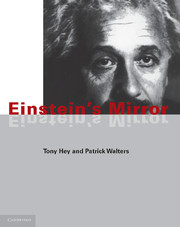Book contents
- Frontmatter
- Contents
- Preface
- 1 A revolution in time
- 2 The nature of light
- 3 Light and time
- 4 The ultimate speed
- 5 E = mc2
- 6 Matter and anti-matter
- 7 Little Boy and Fat Man: relativity in action
- 8 Down to earth
- 9 Warped space
- 10 The Big Bang, black holes unified fields
- 11 Afterword: Relativity and science fiction
- Appendix: Some mathematical details and derivations
- Chronology
- Glossay
- Quotations and sources
- Suggestions further reading
- Name index
- Subject index
- Plate section
10 - The Big Bang, black holes unified fields
Published online by Cambridge University Press: 05 March 2013
- Frontmatter
- Contents
- Preface
- 1 A revolution in time
- 2 The nature of light
- 3 Light and time
- 4 The ultimate speed
- 5 E = mc2
- 6 Matter and anti-matter
- 7 Little Boy and Fat Man: relativity in action
- 8 Down to earth
- 9 Warped space
- 10 The Big Bang, black holes unified fields
- 11 Afterword: Relativity and science fiction
- Appendix: Some mathematical details and derivations
- Chronology
- Glossay
- Quotations and sources
- Suggestions further reading
- Name index
- Subject index
- Plate section
Summary
The sceptic will say ‘It may well be true that this system of equations is reasonable from a logical stand-point, but this does not prove it corresponds to Nature.’ You are right, dear sceptic. Experience alone can decide on the truth.
Albert Einstein, commenting on ‘Unified Field Theory’, 1950The expanding universe
While on Mount Wilson, Einstein and his wife Elsa were given a tour of the observatory. It was explained to them that the giant telescope was used for determining the structure of the universe, to which Elsa replied: ‘Well, well! My husband does that on the back of an old envelope.’
From Man Discovers the Galaxies, 1930After his stunning success with general relativity, Einstein began to think about the implications of his theory for the universe as a whole. In 1917, he wrote a paper that began a new field of physics, that would be called ‘relativistic cosmology’. He wrote to his friend Paul Ehrenfest:
I have… again perpetrated something about gravitation theory which somewhat exposes me to the danger of being confined in a madhouse.
Although Einstein had the nerve to provide the first mathematical model of the universe, he had also, in a sense, lost his nerve at the crucial moment. Instead of predicting Hubble's discovery of the expansion of the universe, a solution that followed naturally from his own field equations, Einstein chose to modify gravity and introduce a new repulsive force.
- Type
- Chapter
- Information
- Einstein's Mirror , pp. 210 - 239Publisher: Cambridge University PressPrint publication year: 1997
- 1
- Cited by



